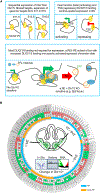Genomic Resolution of DLX-Orchestrated Transcriptional Circuits Driving Development of Forebrain GABAergic Neurons
- PMID: 31433982
- PMCID: PMC6750766
- DOI: 10.1016/j.celrep.2019.07.022
Genomic Resolution of DLX-Orchestrated Transcriptional Circuits Driving Development of Forebrain GABAergic Neurons
Abstract
DLX transcription factors (TFs) are master regulators of the developing vertebrate brain, driving forebrain GABAergic neuronal differentiation. Ablation of Dlx1&2 alters expression of genes that are critical for forebrain GABAergic development. We integrated epigenomic and transcriptomic analyses, complemented with in situ hybridization (ISH), and in vivo and in vitro studies of regulatory element (RE) function. This revealed the DLX-organized gene regulatory network at genomic, cellular, and spatial levels in mouse embryonic basal ganglia. DLX TFs perform dual activating and repressing functions; the consequences of their binding were determined by the sequence and genomic context of target loci. Our results reveal and, in part, explain the paradox of widespread DLX binding contrasted with a limited subset of target loci that are sensitive at the epigenomic and transcriptomic level to Dlx1&2 ablation. The regulatory properties identified here for DLX TFs suggest general mechanisms by which TFs orchestrate dynamic expression programs underlying neurodevelopment.
Keywords: ChIP-seq; DLX; GABA neuron; basal ganglia; chromatin; development; enhancers; ganglionic eminence; genome; histone; regulatory element; telencephalon; transcription factor; transcriptional circuits.
Copyright © 2019 The Author(s). Published by Elsevier Inc. All rights reserved.
Conflict of interest statement
DECLARATION OF INTERESTS
J.L.R.R. is co-founder, stockholder, and currently on the scientific board of Neurona, a company studying the potential therapeutic use of interneuron transplantation. The other authors declare no competing interests.
Figures







References
-
- Anderson SA, Eisenstat DD, Shi L, and Rubenstein JL (1997a). Interneuron migration from basal forebrain to neocortex: dependence on Dlx genes. Science 278, 474–476. - PubMed
-
- Anderson SA, Qiu M, Bulfone A, Eisenstat DD, Meneses J, Pedersen R, and Rubenstein JL (1997b). Mutations of the homeobox genes Dlx-1 and Dlx-2 disrupt the striatal subventricular zone and differentiation of late born striatal neurons. Neuron 19, 27–37. - PubMed
-
- Andrews S (2010). FASTQC. A quality control tool for high throughput sequence data. http://www.bioinformatics.babraham.ac.uk/.
-
- Casarosa S, Fode C, and Guillemot F (1999). Mash1 regulates neurogenesis in the ventral telencephalon. Development 126, 525–534. - PubMed
Publication types
MeSH terms
Substances
Grants and funding
LinkOut - more resources
Full Text Sources
Molecular Biology Databases
Research Materials

